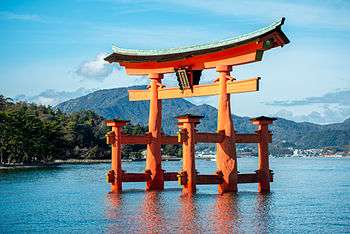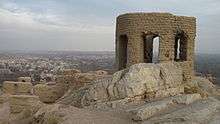Religion and spirituality
Religion and spirituality have played a significant role in humanity's history. Many cultural sights from buildings to festivals and traditions are of a religious nature. Most populated places have at least one place of worship; at least one such place is usually a prominent building, often with more elaborate architecture than secular buildings.

All travellers, religious or not, should learn something about the dominant religions in the countries they visit. Even in communities that seem secular and modern, such as Europe or East Asia, religion has played an important role in customs and values in the past, and often continues to do so to this day, even among people who are no longer religious. Even religions that have now virtually disappeared have left architectural remains, and sometimes a certain influence on other religions. Good examples of this are the old Eastern Christian churches in the Middle East, and the Precolumbian religions and rituals that are still visible under a thin Catholic façade in much of Latin America.
A religious congregation can be the base of an ethnic diaspora, and provide expats and travellers a connection with their people. For example, the Anglican Communion is a communion with the Church of England, with churches in most of the world's countries, with services held in English.
Understand
Religion and politics
Many countries have a state religion, while others, such as most communist countries, are officially atheist. Countries that are neither officially atheist nor have a state religion are called secular, and some of these have laws in place restricting religious worship or observance. For instance, it is illegal to promote any sort of religion in publicly-owned buildings in France; this extends to the wearing of religious clothing accessories such as the crucifix or hijab. However, the official status of religion in a country does not necessarily correspond to religiosity of the general population. For instance, the United States is officially a secular country, but strongly Christian in practice, with nearly half of the population attending church regularly, and politicians often citing the Bible to justify policy decisions. Conversely, Iceland is officially a Lutheran country, but rather secular in practice, with only a minority of the population actively practising the faith, and religion rarely if ever featuring in the political discourse.
Pilgrimage
Before the advent of rail travel and steamships in the 19th century, long-distance travel was hardly a pleasure, and many of those who ventured far from home were motivated by faith. A pilgrimage was, and still remains, a way to find physical fitness, redemption, wisdom, or the meaning of life. Though modern pilgrims can travel fast and comfortably to sacred places, some might, literally and figuratively, choose the narrow path. Some pilgrimage routes have become destinations in their own right as has the "travel infrastructure" of yesteryear - whether it is still in use as such or not. Many pilgrimage routes are also open - and indeed often traveled on - by those of a different faith or no faith at all. Do keep in mind that some pilgrimage routes and destinations are off-limits to non-believers (or different believers) either year round or during special occasions.
Mission
Missionaries and chaplains might find work far from home, usually combined with volunteer work. See also business travel and working abroad.
Religions of the world
Abrahamic religions

Judaism was the first one established, and Christianity and Islam are the largest in terms of number of followers. All three religions have much history and many beliefs in common. Another smaller and more recent one is the Baha'i Faith. They originate from the Holy Land in the Middle East. There are also a number of what are sometimes called post-Christian religions — so called because they hold a post-Biblical text sacred, in addition to the Bible. Most were founded in the United States, notably including the Church of Jesus Christ of Latter-day Saints (Mormon), Jehovah's Witnesses and Seventh Day Adventists, which have quite a few adherents worldwide.
- Holy Land for religious destinations in the Middle East
- Fátima, a Marian city known as "the altar of the World"
- Way of Saint James (to Santiago de Compostela)
- Painted Monasteries in northern Romania
- Protestant Reformation
- Hajj, the Muslim pilgrimage to Mecca
- Travelling during Ramadan
- Kashrut, Jewish dietary laws
Dharmic religions
Hinduism and Buddhism have their origins in India, together with some associated religions with much smaller numbers of adherents, such as Jainism and Sikhism. While Hinduism also flourished in much of Southeast Asia for hundreds of years, it was ultimately replaced by other religions there, with a few exceptions such as Bali. Hinduism has largely remained local to South Asia ever since, except for proselytic movements such as Hare Krishna and migrants of South Asian descent. However, Buddhist values have influenced a wide range of Asian lands. Sikhism is still largely concentrated in the Indian state of Punjab, though there are Sikh diasporas in many parts of the world, most notably the United Kingdom, Canada and Malaysia.
You will notice the mention of yoga and meditation below. That's because both disciplines were highly developed in ancient times by Hindu and Buddhist masters, so that while many types of meditation exist and yoga nowadays is often practiced outside of Hindu and Buddhist countries in a non-religious manner, the origins of yoga and at least the most influential styles of meditation are in these dharmic religions.
- Sacred sites of the Indian sub-continent
- Meditation in Japan
- Meditation in Thailand
- Meditation retreat centers
- Yoga
- 88 Temple Pilgrimage
East Asian religions
While much of East Asia is Buddhist, and there are many Muslims in China and Mongolia, and many Christians in South Korea there are also some religions which developed within the region.
In China:
- Confucianism is more a code of conduct than what Westerners would consider a religion, though literary temples (文庙 wénmiào), also known as Confucius temples (孔庙 kǒngmiào or 夫子庙 fūzǐmiào), dedicated to the worship of Confucius exist both in China, and in Chinese-influenced civilisations such as Vietnam (Văn Miếu in Vietnamese), Korea (문묘 munmyo in Korean) and Japan (孔子廟 kōshi-byō in Japanese). It emphasizes respect for one's ancestors and willingness to play one's role in society, and also places a strong emphasis on education and study. One of the most noticeable influences from Confucianism you may notice in East Asian religious practices is ancestor worship. It has had considerable influence in various nations near China; see Imperial China for discussion. Both Confucius's birthplace, Qufu, and that of Mencius, Zoucheng, draw both pilgrims and tourists.
- Taoism is based on meditation and the notion of wu wei (无为/無為) (non-action, going with the flow). It provides a mystical counterpoint to Confucianism and has had a large influence on some schools of Buddhism, notably Zen. There are famous statues of the founder, Lao-tzu, on San Shan Island in Lake Tai and Qingyuan Mountain in Quanzhou. While in its narrowest sense it refers only to the philosophy based on teachings of Lao-tzu, the term is often used in a broader sense to refer to the worship of traditional Chinese deities.
In Japan:

- Shinto is a Japanese tradition emphasizing mysticism and patriotism.
In Korea:
- Muism, or Korean Shamanism was the traditional religion of the Korean people. Though Buddhism and Confucianism eventually became more popular after their introduction from China, many Shamanistic practices continue to survive in Korean culture. A Shamanistic ritual called a gut (굿) is often performed on the site before the construction of a new building.
Unlike Western religions, these tend not to demand exclusivity. It is fairly common in East Asian countries for someone to adopt some practices from more than one of these, and often from Buddhism as well, and there are many Chinese temples devoted to deities from more than one of these religions. Similarly, in Japan, prior to their forced separation following the Meiji Restoration in 1868, the distinction between Shinto shrines and Buddhist temples was often blurry, with temple complexes often being dedicated to deities from both religions. Even today, despite their separation, most Japanese continue to offer prayers at both Shinto shrines and Buddhist temples for different festivals.
Other movements

While the religions mentioned above are the most prolific, virtually all peoples of the world have some kind of spiritual tradition. For instance, the original pre-Islamic religion of the Persian people, Zoroastrianism, which was moderately important 600BCE-600CE, declined considerably after Islam reached Persia but continues to survive in Iran, India and other parts of the world.
Some religions have gone extinct and been revived, such as Celtic and Old Norse paganism. Even disappeared ones may have left a mark on subsequent religions or "secular" traditions, but the exact extent is often hard to gauge as many cultures abandoned their former religion before the introduction of writing, and missionaries often tried to hide the fact that "the feast of Saint whatshisface" bears some striking similarities to the former "feast of God whatshername". Hinduism is believed by many modern scholars to share a common origin with many pre-Christian European mythologies, as well as pre-Islamic Persian mythology.
Respect
| “ | Lasciate ogni speranza, voi ch'entrate. Abandon hope all ye who enter here. |
” |
—Inferno, Dante Alighieri | ||
Religion is a sensitive topic, and a component in many international and regional conflicts. A comprehensive guidebook of all religious customs in the world would be very long; as a general principle, travellers should learn about ethics prescribed by the dominant religions at the destination.